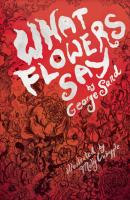What Flowers Say. George Sand
Чтение книги онлайн.

Читать онлайн книгу What Flowers Say - George Sand страница
Название: What Flowers Say
Автор: George Sand
Издательство: Ingram
Жанр: Природа и животные
isbn: 9781558618787
isbn:
Published in 2014 by the Feminist Press
at the City University of New York
The Graduate Center
365 Fifth Avenue, Suite 5406
New York, NY 10016
Text copyright © 1994 by Holly Erskine Hirko
Cover and interior illustrations copyright © 2014 by Molly Crabapple
All rights reserved.
| This book was made possible thanks to a grant from New York State Council on the Arts with the support of Governor Andrew Cuomo and the New York State Legislature. |
No part of this book may be reproduced, used, or stored in any information retrieval system or transmitted in any form or by any means, electronic, mechanical, photocopying, recording, or otherwise, without prior written permission from the Feminist Press at the City University of New York, except in the case of brief quotations embodied in critical articles and reviews.
First printing November 2014
Cover design by Molly Crabapple
Text design by Drew Stevens
Library of Congress Cataloging-in-Publication Data
Sand, George, 1804-1876.
[Contes d’une grand-mére. English]
What flowers say and other stories / George Sand ; translated by Holly Erskine Hirko ; illustrated by Molly Crabapple.
pages cm
Previously published in 1994 under the title: The Castle of pictures and other stories.
ISBN 978-1-55861-878-7 (ebook)
1. Fairy tales—France. 2. Children’s stories, French—Translations into English. [1. Fairy tales. 2. Short stories.] I. Hirko, Holly Erskine, translator. II. Crabapple, Molly, illustrator. III. Title.
PZ8.S2495Wh 2014
[Fic]—dc23
2014031227
Contents
The Castle of Pictordu
The Talking Statue
The Veiled Lady
The Young Lady of Pictordu
Little Bacchus
The Lost Face
Looking for the Face
The Face Rediscovered
The Collapse
Return to Pictordu
The Statue’s Speech
George Sand was a woman, born Aurore Dupin in Paris, France, in 1804. She took on a masculine name because, as an aspiring writer, she knew that her work would be more seriously considered if people thought the author was a man. She kept the name throughout her life, and became one of France’s most beloved and prolific writers, publishing more than eighty novels and plays.
The same freedom that Sand exercised in her writing, she applied to the rest of her life. In nineteenth-century France, women were expected to wear long dresses with tight corsets, but instead Sand wore men’s clothing, which allowed her to move more freely and to gain access to places otherwise restricted to women. She smoked cigars and dated whomever she wanted to date. Sand’s behavior may have been seen as unladylike, but she lived a liberated life at a time when liberation for women was in short supply.
Sand wrote What Flowers Say for her granddaughters only a few years before her death. She wanted to leave behind stories that would convey her strong belief in fantasy, to urge them to consider the unseen. Maybe it was Sand’s endless imagination that enabled her to create a revolutionary life. Believe and live free. That lesson is the gift she gave to her granddaughters with this collection, and that we are passing on to you, the reader, nearly one hundred and fifty years later.
When I was a child, my dear Aurore, I was tormented by the fact that I wasn’t able to hear what flowers said when they talked to each other. My botany professor assured me they said nothing. Whether he was deaf or he didn’t want to tell me the truth, he swore they said nothing at all.
I knew he was wrong. I would hear them chattering, especially in the evening when the dew began to form; but they spoke too low for me to make out their words. Furthermore, they were distrustful, and when I would walk by the flower beds or along the path in the meadow, they would warn each other with a sort of “shhh,” which they passed from one to the other. It was as if they said from start to finish, “Watch out, be quiet! Here comes that curious little girl who listens to us.”
But I persisted. I practiced walking very quietly without disturbing the smallest blade of grass, so they wouldn’t hear me and so I could get very, very close. Then, by bending way down under the shade of the trees so they couldn’t see my shadow, I finally heard some words clearly.
I had to pay close attention. The little voices were so soft and low that the least little breeze would carry them away, and the humming of sphinx moths and other night moths would cover their voices completely.
I don’t know what language they were speaking. It wasn’t my native French or the Latin I was studying at that time. But it so happened that I was able to understand it very well. It even seemed to me I could understand this language better than any I had heard СКАЧАТЬ